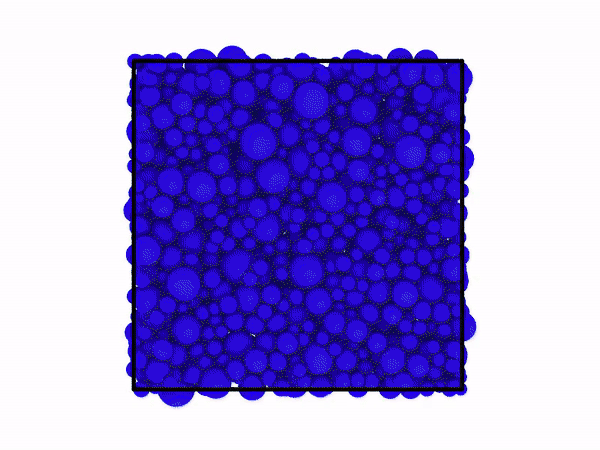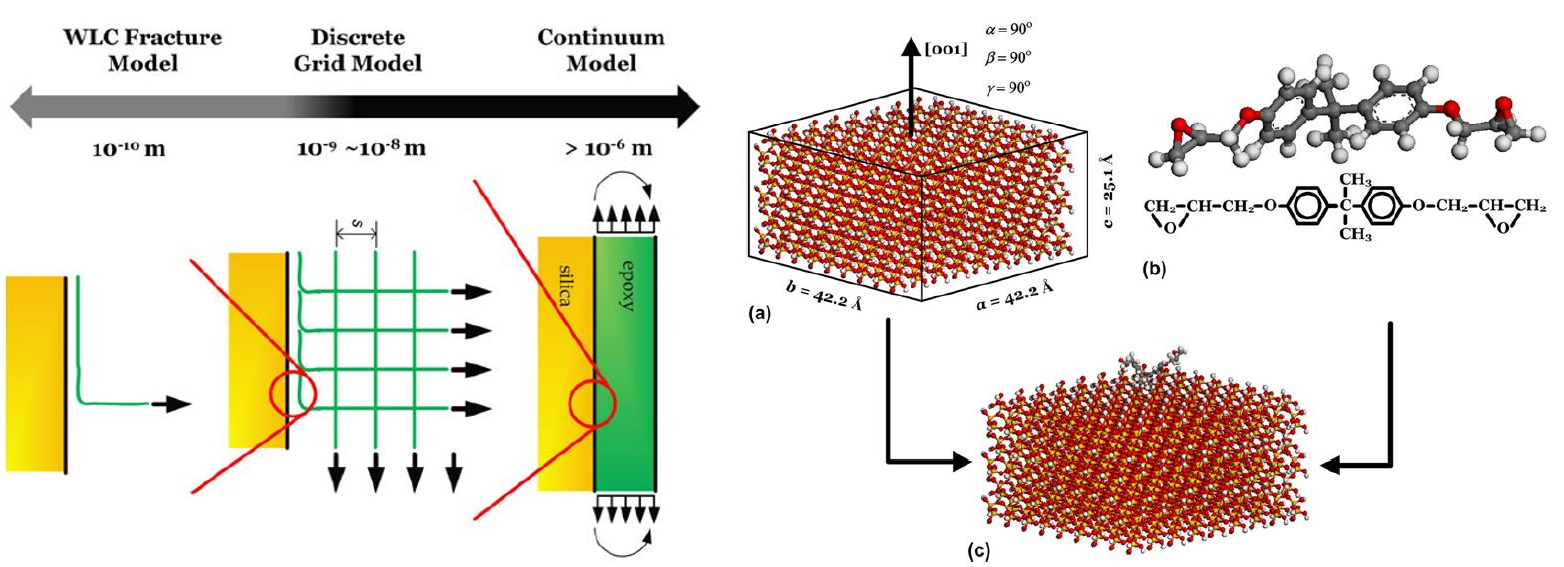

We propose a cohesive-frictional-force-field (CFFF) that describes the interactions in colloidal C-S-H materials by incorporating strength anisotropy in the C-S-H molecular strcuture. This fundamental behavior was typically omitted from previous mesoscale models. We parameterize the CFFF from reactive force field simula- tions of an internal interface that controls mechanical performance, describing the behav- ior of thousands of atoms through a single effective pair interaction. We apply the CFFF to study the mesoscale elastic and Mohr–Coulomb strength properties of C-S-H with varying polydispersity and packing density. Our results show that the consideration of cohesive- frictional interactions lead to an increase in stiffness, shear strength, and normal-stress dependency, while also changing the nature of local deformation processes. The CFFF and our coarse-graining approach provide an essential connection between nanoscale molecu- lar interactions and macroscale continuum behavior for hydrated cementitious materials.



S. D. Palkovic, S. Yip and O. Buyukozturk. A cohesive-frictional force field (CFFF) for colloidal calcium-silicate-hydrates. Journal of the Mechanics and Physics of Solids 2017; 109: 160-177.
MIT News, A concrete solution
Atomistic models provide a bottom-up description of material properties and processes, and molecular dynamics (MD) simulation is capable of solving the dynamic evolution of equilibrium and non-equilibrium processes. The applicability of the technique to structural engineering problems is demonstrated through an interface debonding problem in a multi-layered material system usually encountered in composite structures. Interface debonding may lead to a possible premature failure of fiber reinforced polymer (FRP) bonded reinforced concrete (RC) structural elements subjected to moisture. Existing knowledge on meso-scale fracture mechanics may not fully explain the weakening of the interface between concrete and epoxy, when the interface is under moisture; there is a need to study the moisture affected debonding of the interface using a more fundamental approach that incorporates chemistry in the description of materials. The results of the atomistic modeling presented in this paper show that the adhesive strength (in terms of energy) between epoxy and silica is weakened in the presence of water through its interaction with epoxy. This is correlated with the existing meso-scale experimental data. This example demonstrates that MD simulation can be effectively used in studying the durability of the system through an understanding of how materials interact with the environment at the molecular level. In view of the limitation of MD simulation on both length- and time-scales, future research may focus on the development of a bridging technique between MD and finite element modeling (FEM) to be able to correlate the results from the nano- to the macro-scale.
O. Buyukozturk, M. J. Buehler, D. Lau and C. Tuakta. Structural solution using molecular dynamics: Fundamentals and a case study of epoxy-silica interface. International Journal of Solids and Structures 2011; 48(14-15): 2131-2140.
MIT News, Study takes a micro-mechanics approach to understanding material deterioration
We devise a multiscale approach to study the intrinsic strength between expoxy and silica which primarily features nonbonded and nondirectional van der Waals and Coulombic chemical interactions. We combine molecular dynamics simulations with metadynamics method to reconstruct the free energy surface between attached and detached states of the bonded system. This is subsequently scaled up to be incorporated in a continuum model through a finite element approach to predict the structural behavior of epoxy-silica interface. The predictions show good agreement with existing experimental results.

D. Lau, O. Buyukozturk and M. J. Buehler. Characterization of the intrinsic strength between epoxy and silica using a multiscale approach. Journal of Materials Research 2012; 27(14): 1787-1796.
The objective of this research is to develop an in-depth mechanistic understanding of moisture affected debonding in FRP retrofitted concrete using an interface fracture approach, which rigorously and precisely quantifies the debonding problem by means of interface fracture toughness, G, representation of the bonded system. While the strength approach is capable of quantifying and analyzing material decohesion type of debonding, it intrinsically lacks the ability to describe adhesion related phenomenon. Interface fracture toughness is, on the other hand, considered a bond property of the multi-layer material system, and is a quantification parameter central to this proposed research. The interface fracture approach is particularly robust due to the fact that the bond property is assessed on bond lines of the real scale that can easily be replicated in laboratory settings and does not involve size effects.


C. Tuakta and O. Buyukozturk. Conceptual Model for Prediction of FRP/Concrete Bond Strength under Moisture Cycles. Journal of Composites for Construction 2011; 15 (5): 743-756.
Accurate measurement of interfacial properties is critical any time two materials are bonded—in composites, tooth crowns, or when biomaterials are attached to the human body. Yet, in spite of this importance, reliable methods to measure interfacial properties between dissimilar materials remain elusive. Here we present an experimental approach to quantify the interfacial fracture energy Gi that also provides unique mechanistic insight into the interfacial debonding mechanism at the nanoscale. This approach involves deposition of an additional chromium layer (superlayer) onto a bonded system, where interface debonding is initiated by the residual tensile stress in the superlayer, and where the interface can be separated in a controlled manner and captured in situ. Contrary to earlier methods, our approach allows the entire bonded system to remain in an elastic range during the debonding process, such that Gi can be measured accurately. We validate the method by showing that moisture has a degrading effect on the bonding between epoxy and silica, a technologically important interface. Combining in situ through scanning electron microscope images with molecular simulation, we find that the interfacial debonding mechanism is hierarchical in nature, which is initiated by the detachment of polymer chains, and that the three-dimensional covalent network of the epoxy-based polymer may directly influence water accumulation, leading to the reduction of Gi under presence of moisture. The results may enable us to design more durable concrete composites that could be used to innovate transportation systems, create more durable buildings and bridges, and build resilient infrastructure.
D. Lau, K. Broderick, M. J. Buehler and O. Buyukozturk. A robust nanoscale experimental quantification of fracture energy in a bilayer material system. Proceedings of the National Academy of Sciences 2014; 111(33): 11990-11995.
MIT News, Learning how things fall apart
X.Q. Wang, O. Buyukozturk, C.K.Y. Leung, and D. Lau. Atomistic prediction on the degradation of vinylester-based composite under chloride and elevated temperature. Composites Science and Technology 2022, 226: 109539
X.Q. Wang, W. Jian, O. Buyukozturk, C.K.Y. Leung, and D. Lau. Degradation of epoxy/glass interface in hygrothermal environment: An atomistic investigation. Composites Part B: Engineering 2021, 206, 108534.
S. Palkovic, K. Kupwade-Patil, A. Bumajdad and O. Buyukozturk. Random field finite element models with cohesive-frictional interactions of a hardened cement paste microstructure. Journal of Mechanics and Physics of Solids 2018; 119: 349-368.
S. D. Palkovic, S. Yip and O. Buyukozturk. A cohesive-frictional force field (CFFF) for colloidal calcium-silicate-hydrates. Journal of the Mechanics and Physics of Solids 2017; 109: 160-177.
S. D. Palkovic, S. Yip and O. Buyukozturk. Constitutive response of calcium-silicate-hydrate layers under combined loading. Journal of the American Ceramic Society 2017; 100(2): 713-723.
A. Zhou, O. Buyukozturk and D. Lau. Debonding of concrete-epoxy interface under the coupled effect of moisture and sustained load. Cement and Concrete Composites 2017. 80: 287-297.
S. D. Palkovic, S. Moeini, S. Yip and O. Buyukozturk. Mechanical behavior of a composite interface: Calcium-silicate-hydrates. Journal of Applied Physics 2015; 118(3): 034305.
D. Lau, K. Broderick, M. J. Buehler and O. Buyukozturk. A robust nanoscale experimental quantification of fracture energy in a bilayer material system. Proceedings of the National Academy of Sciences 2014; 111(33): 11990-11995.
O. Gunes, D. Lau, C. Tuakta and O. Buyukozturk. Ductility of FRP–concrete systems: Investigations at different length scales. Construction and Building Materials 2013; 49:915-925.
D. Lau, O. Buyukozturk and M. J. Buehler. Characterization of the intrinsic strength between epoxy and silica using a multiscale approach. Journal of Materials Research 2012; 27(14): 1787-1796.
O. Buyukozturk, M. J. Buehler, D. Lau and C. Tuakta. Structural solution using molecular dynamics: Fundamentals and a case study of epoxy-silica interface. International Journal of Solids and Structures 2011; 48(14-15): 2131-2140.
C. Tuakta and O. Buyukozturk. Conceptual Model for Prediction of FRP/Concrete Bond Strength under Moisture Cycles. Journal of Composites for Construction 2011; 15 (5): 743-756.
C. Tuakta and O. Buyukozturk. Deterioration of FRP/concrete bond system under variable moisture conditions quantified by fracture mechanics. Composite Part B: Engineering 2011; 42(2): 145-154.
H. Ozkaynak, E. Yuksel and O. Buyukozturk, C. Yalcin and A. A. Dindar. Quasi-static and pseudo-dynamic testing of infilled RC frames retrofitted with CFRP material. Composite Part B: Engineering 2010; 42(2): 238-263.
D. Lau and O. Buyukozturk. Fracture Characterization of Concrete/Epoxy Interface Affected by Moisture. Mechanics of Materials 2010; 42(12): 1031-1042.
E. Yuksel, H. Ozkaynak, O. Buyukozturk, C. Yalcin, A. A. Dindar, M. Surmeli and D. Tastan. Performance of alternative CFRP retrofitting schemes used in infilled RC frames. Construction and Building Materials 2010; 24(4): 596-609.
D. Lau and O. Buyukozturk. Fracture Characterization of Concrete/Epoxy Interface Affected by Moisture. Mechanics of Materials 2010; 42(12): 1031-1042.
O. Gunes, O. Buyukozturk and E. Karaca. A Fracture-based Model for FRP Debonding in Strengthened Beams. Engineering Fracture Mechanics 2009; 76 (12): 1897-1909.
C. Au and O. Buyukozturk. Peel and shear fracture characterization of debonding in FRP plated concrete affected by moisture. Journal of Composites for Construction 2006; 10(1): 35-47.
O. Buyukozturk, T.-Y. Yu and J.A. Ortega. A methodology for determining complex permitivity of construction materials based on transmission-only coherent, wide-bandwidth free-space measurements. Cement and Concrete Composites 2006; 28(4): 349-359.
O. Buyukozturk, O. Gunes and E. Karaca. Progress on understanding debonding problems in reinforced concrete and steel members strengthened using FRP composites. Construction and Building Materials 2004; 18(1): 9-19.
O. Buyukozturk and B. Hearing. Failure behavior of precracked concrete beams retrofitted with FRP. Journal of composites for construction 1998; 2(3): 138-144.
H.C. Rhim and O. Buyukozturk. Electromagnetic properties of concrete at microwave frequency range. Materials Journal 1998; 95(3): 262-271.
M. Valle and O. Buyukozturk. Behavior of fiber reinforced high-strength concrete under direct shear. Materials Journal 1993; 90(2): 122-133.
O. Buyukozturk, M. M. Bakhoum and S. M. Beattie. Shear Behavior of Joints in Precast Concrete Segmental Bridges. Journal of Structural Engineering 1990; 116(12): 3380-3401.
O. Buyukozturk and T-M. Tseng. Concrete in Biaxial Cyclic Compression. Journal of Structural Engineering 1984; 110(3): 461-476.
O. Buyukozturk. Nonlinear analysis of reinforced concrete structures. Computers & Structures 1977; 7(1): 149-156.
O. Buyukozturk, A.H. Nilson and F.O. Slate. Stress-strain response and fracture of a concrete model in biaxial loading. Journal of American Concrete Institute 1971; 68(8): 590-599.
Back to top